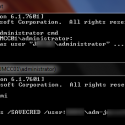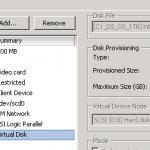Just thought I would record a few notes/thoughts on my recent solar installation in case I need to illustrate it to anyone I know.
For the solar photovoltaic (PV) panels there was two choices: Sharp (Japanese) or SolarWorld (German) panels. According to David (our installer) there is little difference bar aesthetics, although the Sharp ones can be paid for in installments if desired.
The photo below shows the 16 SolarWorld panels on our roof:
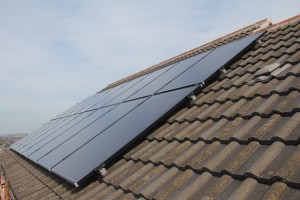
The cables from these panels connect to a Sunny Boy inverter in our roof space. The cables from the panels are the black ones at the bottom left. There is a display panel showing stats but the powerline ethernet adapter (top right) sends stats out to their server where the stats can be viewed online. The grey cable at the top-left carries the converted AC current out of the roofspace ….
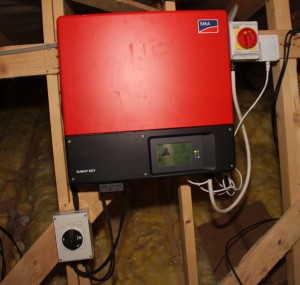 and down the outside of the house ….
and down the outside of the house ….
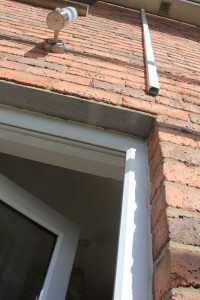
entering the house close to our normal consumer unit (fusebox):
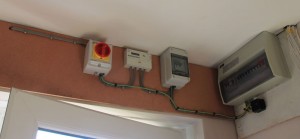 Traditionally any electricity generated but not used is sent back out to the grid – where it is used by others. You are compensated for this at a meagre 5p (approx) for unit. Since 5p doesn’t make a lot of sense, this is where the iBoost comes in….
Traditionally any electricity generated but not used is sent back out to the grid – where it is used by others. You are compensated for this at a meagre 5p (approx) for unit. Since 5p doesn’t make a lot of sense, this is where the iBoost comes in….
iBoost for Hot Water
The iBoost that we had as part of our installation allows us to divert this electricity from going out on to the grid and is instead used to heat water (like having the immersion heater switched on).
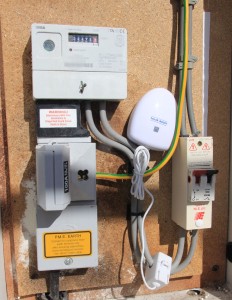 A device (shown in the image above) monitors the cable to identify when electricity is being pushed out on to the grid. This device is paired with the panel inside the house (see below) which switches on heating of the water so electricity is not sent out to the grid. On bright days this gives loads of hot water.
A device (shown in the image above) monitors the cable to identify when electricity is being pushed out on to the grid. This device is paired with the panel inside the house (see below) which switches on heating of the water so electricity is not sent out to the grid. On bright days this gives loads of hot water.
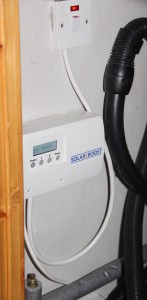
Costs and Returns
So the cost of the installation came in at a touch over £6,000. We had been paying roughly £100 per month for electricity. Based on David’s projections (customised according to our aspect and current electrical usage) we should hope to reduce our monthly bill by £34 -ish per month, with the income from the ROCS scheme giving us around £500 per year. (Note: these figures are variable based on several things – covered by David).
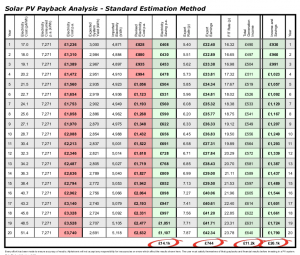 So we would hope to cover the costs of the installation within 6 years based on the income from the ROCS scheme and the savings on our electricity bills.
So we would hope to cover the costs of the installation within 6 years based on the income from the ROCS scheme and the savings on our electricity bills. 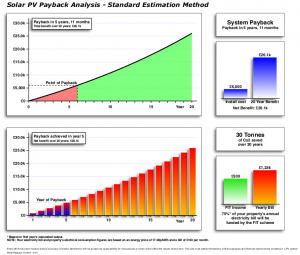
The lifespan of the panels is 20-25 years so even after we have covered our initial outlay we continue to save on our electricity bills and continue to receive the ROCS payments.
Questions:
How long did the work take?
David came to meet us, explained everything in under an hour and left us with the costs and projections. Once we agreed, the scaffolding magically appeared a few days before the scheduled works date and the actual installation work was all done within a single day.
Can you store electricity generated during the day in batteries for use at night?
One of the questions I have been asked is whether there is an ability to store electricity generated during the day for use at night e.g. in batteries. This doesn’t appear to be a good idea (economically or environmentally) read more here if you want.
UPDATE: Battery storage announced by Tesla and Backflow issues danger to grid
